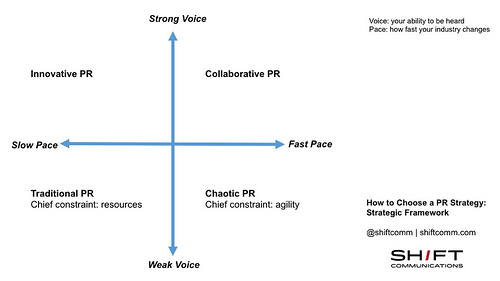Strategy is one of the most abused, misused words in the entire lexicon of business. Ask 100 executives what strategy means and you’ll get 150 different answers. In this six-part series, we’ll look at how to choose a PR strategy based on visible, measurable criteria and a meta-strategic framework. Today, we’ll examine the traditional PR environment.
Recall that our framework for choosing a PR strategy is based on two dimensions, pace (how fast things change) and voice (how easy it is to be heard):

The chaotic PR environment is one many industries face, defined by a fast pace and a weak voice. There’s no commanding leader in the space, no big fish that everyone can go after. Instead, lots of competitors are jockeying for position, and the environment is changing so fast that customers aren’t sure who to choose or what to do.
Some examples of the chaotic environment would include companies in the the SEO space, or Android development, or organic foods. Try it now: without Googling, name a top SEO firm. Name the #1 Android developer that you know of. Name a dominant brand of organic food. Chances are you can’t name any, because these are fields where winners and losers change so fast that no brand has a chance to capitalize on a market lead.
Here’s another very graphical example of weak voice and rapid change from Scott Brinker’s MarTech blog, illustrating the change in the marketing technology landscape in a year. Look how many competitors emerged in just 12 months:

The defining factor of a chaotic environment is typically any industry where a third party, outside the control of the brand, changes the rules frequently. For example, social media marketers struggle to keep up with changes to the Facebook algorithm. They have no insight into how it works, how often it changes, or what the changes are beyond vague statements and guesses.
Think about the travel industry. If you’re a hotel, a convention/visitors’ bureau, or a destination, you operate at the whims of weather, the economy, and the transportation industry (and its associated fuel costs & ticket prices). This is a chaotic environment that makes classical PR strategy fall apart. By the time you settle on a strategy, the conditions that went into your initial thinking have changed, potentially invalidating the strategy or producing the opposite of the desired outcome.
How To Choose A Chaotic Strategy
In the chaotic environment, agility defines whether you win or lose. Instead of betting big on a 5 year master PR and marketing plan, you might at best have a 5 month PR plan, or even a 5 day PR plan. The most agile companies might have several simultaneous short term plans operating at the same time.
What strategies and tactics fit well in a chaotic environment? Choose any strategy that iterates rapidly and has quick termination capabilities. Rather than bet big, bet small but many times. Don’t aim to have the major influencer alone support your brand; in fact, don’t even bank on influencers alone.
Companies with true omni-channel capabilities do well in a chaotic environment. If Facebook’s rules change today, you have Twitter, email, SMS, and broadcast as backups. You combined earned, owned, paid, shared, and rented media in multiple, different combinations, and you go to market with different mixes of media. Every plan hits multiple touchpoints, reaches people in different ways.
Where You’ll Go Wrong
The biggest mistake is believing that you’re operating in a chaotic environment when you’re not – especially if your environment is traditional. Recall that in a traditional environment, focused power wins. A chaotic strategic plan is the equivalent of lots of little shots instead of one big shot. A thousand row boats with slingshots aren’t even going to dent the hull of a battleship.
The other key mistake in a chaotic environment is being insufficiently agile. Companies and brand managers tend to get wedded to certain platforms, certain methods, and struggle to part ways with something even if early results are showing ineffectiveness. The watchword/watchphrase is “we just need to give this a little more time”. When you hear that phrase uttered in a chaotic environment, you have a potential danger to your ability to be agile.
In the next post in this series, we’ll look at a different kind of environment: one in which you can take the lead because no one else has found it yet.
This article was syndicated from Business 2 Community: How to Choose a PR Strategy, Part 3 of 6: Chaotic environment
More Sales & Marketing articles from Business 2 Community:




